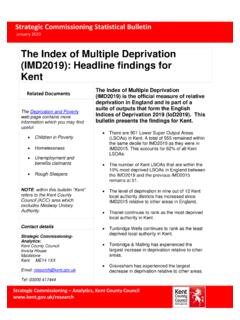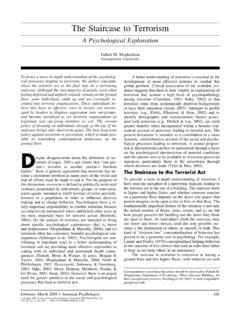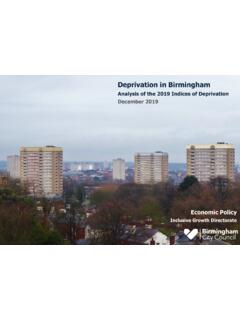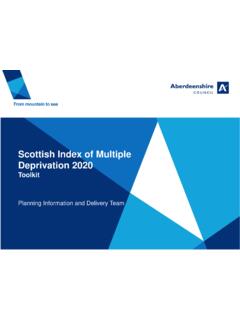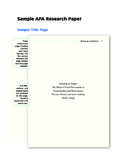Transcription of The English Index of Multiple Deprivation (IMD) 2015 Guidance
1 1 The English Index of Multiple Deprivation (IMD) 2015 Guidance This Guidance note is to aid interpretation of the Index of Multiple Deprivation . It expands on the information provided in the infographic. A full list of the data files and supporting documents available for the Indices of Deprivation 2015 is provided in the annex at the end of this note. All of the data files and supporting documents are available from: What is the Index of Multiple Deprivation 2015 and how can I use it? The Index of Multiple Deprivation 2015 is the official measure of relative Deprivation for small areas1 (or neighbourhoods) in England.
2 The Index of Multiple Deprivation ranks every small area in England from 1 (most deprived area) to 32,844 (least deprived area). It is common to describe how relatively deprived a small area is by saying whether it falls among the most deprived 10 per cent, 20 per cent or 30 per cent of small areas in England (although there is no definitive cut-off at which an area is described as deprived ). To help with this, Deprivation deciles are published alongside ranks. Deciles are calculated by ranking the 32,844 small areas in England from most deprived to least deprived and dividing them into 10 equal groups.
3 These range from the most deprived 10 per cent of small areas nationally to the least deprived 10 per cent of small areas nationally. 1 Lower-layer Super Output Areas, based on the 2011 Census. 2 You can use this information to describe the relative level of Deprivation in an area. For example: Small area X is ranked 5,000 out of 32,844 small-areas in England, where 1 is the most deprived. This means that small area X is amongst the 20 per cent most deprived small areas in the country. You can look up Deprivation data for a small area: on a dataset, if you know the small area s name or code.
4 You can find the data here. File 1 contains the Index of Multiple Deprivation ranks and deciles for all small areas in England and is sufficient for the purposes of most users. using an interactive mapping tool. One example is our Indices of Deprivation explorer. By entering a postcode or place name, you can see the small area that the postcode or place lies in, and information on its Deprivation relative to other small areas: You can find out about the range of tools available to help you use the data, including mapping tools and postcode look-ups, in the Frequently Asked Questions document. A note on small areas The small areas used are called Lower-layer Super Output Areas, of which there are 32,844 in England.
5 They are designed to be of a similar population size with an average of 1,500 residents each and are a standard way of dividing up the country. They do not have descriptive place names (in the way that local wards do), but are named in a format beginning with the name of the local authority district followed by a 4 character code eg City of London 001A. For ease of communication, these small areas are sometimes described as neighbourhoods, for example, in the Statistical Release which accompanies the data. What do people use the Index of Multiple Deprivation for? National and local organisations use the Index of Multiple Deprivation , sometimes in conjunction with other data, to distribute funding or target resources to areas.
6 It is widely used across central government to focus programmes on the most deprived areas. Locally, it is often used as evidence in the development of strategies, to target interventions, and in bids for funding. The voluntary and community sector also uses the Index , for example, to identify areas where people may benefit from the services they provide. 3 What other Indices are available? The Index of Multiple Deprivation is part of the Indices of Deprivation and it is the most widely used of these indices. It combines information from seven domain indices (which measure different types or dimensions of Deprivation ) to produce an overall relative measure of Deprivation .
7 You can use the domain indices on their own to focus on specific aspects of Deprivation . There are also supplementary indices concerned with income Deprivation among children (IDACI) and older people (IDAOPI). The Index of Multiple Deprivation is designed primarily to be a small-area measure of Deprivation . But the Indices are commonly used to describe Deprivation for higher-level geographies including local authority districts. A range of summary measures is available allowing you to see where, for example, a local authority district is ranked between 1 (the most deprived district in England) and 326 (the least deprived district in England).
8 Summary measures are also available for upper tier local authorities, local enterprise partnerships and clinical commissioning groups. What can you use the Index of Multiple Deprivation 2015 for? Comparing small areas across England The Index of Multiple Deprivation 2015 uses the same data sources and combines them in the same way for every small area in England. This means you can directly compare the ranks of different small areas in England. If a small area s rank is closer to 1 than that of another area, it is more deprived. Identifying the most deprived small areas You can identify which small areas are amongst the most deprived in England using the published deciles, for example, to show which areas are amongst the 10 per cent or 20 per cent most deprived small areas nationally.
9 You can also apply different cut points to the ranks to identify, for example, the 1 per cent or 5 per cent most deprived small areas nationally. Exploring the domains (or types) of Deprivation You can look at the domain indices to explore which types of Deprivation , income or health, are more prominent within areas or to focus on particular types of Deprivation and explore how areas rank on these. 4 Comparing larger areas local authorities A range of summary measures highlighting different aspects of Deprivation are provided for larger areas, including local authority districts. Because patterns of Deprivation across larger areas can be complex, there is no single summary measure that is the best measure.
10 Comparison of the different measures is needed to give a fuller description of Deprivation for larger areas. You can find out more in section of the Research Report. Looking at changes in relative Deprivation between versions ( changes in ranks) All of the Indices of Deprivation measure relative Deprivation at small area level as accurately as possible, but they are not designed to provide backwards comparability with previous versions of the Indices (2010, 2007, 2004 and 2000). However, because there is a broadly consistent methodology between the Indices of Deprivation 2015 and previous versions, you can compare the rankings as determined at the relevant time point by each of the versions.











